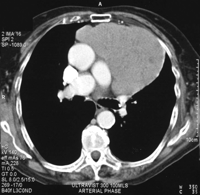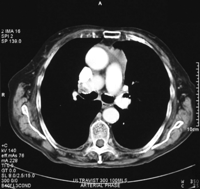-
PDF
- Split View
-
Views
-
Cite
Cite
Shaney Barratt, Zudin A. Puthucheary, Martin Plummeridge, Complete regression of a thymoma to glucocorticoids, commenced for palliation of symptoms, European Journal of Cardio-Thoracic Surgery, Volume 31, Issue 6, June 2007, Pages 1142–1143, https://doi.org/10.1016/j.ejcts.2007.02.032
Close - Share Icon Share
Abstract
A patient is presented with Type B1 thymoma that showed complete regression to oral glucocorticoids commenced for palliation of symptoms. The patient has remained symptom free without radiological recurrence after 12 months.
1 Introduction
Thymomas are epithelial tumours of the thymus. The World Health Organisation (WHO) classification is based on histological analysis of epithelial cell atypia and the degree of infiltration of non-neoplastic lymphocytes [1]. The natural history of their growth can vary considerably from indolence to local invasion or even dissemination into the pleural cavity. Common symptoms at diagnosis include those of constitutional illness, superior vena cava syndrome, phrenic nerve palsy or pleural effusions. Approximately 30% of those diagnosed are asymptomatic at presentation [2].
2 Case report
An 86-year-old lady was referred by her GP for investigation of a persistent cough. She was otherwise asymptomatic.
A chest X-ray revealed a widened mediastinum and subsequent CT Thorax revealed a well-defined, lobulated mass (approximately 10 cm × 12 cm) within the anterior mediastinum, compressing the major vessels (Fig. 1 ). The differential white cell count revealed an excess of lymphocytes but no phenotypic abnormalities on immunological testing.

She initially declined any further investigation of the mass but agreed to a CT guided biopsy 11 months later when admitted with a right femoral deep vein thrombosis.
The histology was consistent with a WHO classification type B1 thymoma (lymphocyte predominant tumour). The patient did not wish to receive any treatment.
Over the subsequent 5 months she developed progressive exertional dyspnoea. Clinically there was no evidence of secondary complications. Dexamethasone (2 mg twice daily) was commenced palliatively to improve her sense of well-being. This was reduced 3 months later to 2 mg once a day due to fluid retention. Attempts at further dose reduction were unacceptable to the patient because of recurrence of symptoms.
She was readmitted 4 months later with pleuritic chest pain. Her chest X-ray demonstrated complete resolution of the mediastinal mass. CT pulmonary angiography showed multiple pulmonary emboli but minimal soft tissue in the anterior mediastinum and small volume paratracheal lymph nodes (≪1 cm) (Fig. 2 ). At this stage her steroids were stopped.

Serial chest X-rays performed over the last 12 months have not revealed any recurrence of the mass. She remains anticoagulated for her thromboembolic disease.
3 Discussion
Surgery remains the mainstay of therapy for all thymomas. Patients with type A, AB or B1 have a good prognosis. One study quoted >89% of B1 thymomas were amenable to complete resection [3]. There is little data on additional therapies in these patients in whom resection is impossible or partial [4].
Those with more aggressive tumours should be considered for adjuvant radiotherapy or chemotherapy. In one study an overall response rate of 30% was seen in patients with advanced thymomas that were treated with octreotide following progression of disease despite radiotherapy [5].
To date there have been three isolated case reports documenting the response of thymic tumours to corticosteroids alone [6–8]. A recent study of 17 patients with invasive thymoma showed a significant reduction in tumour size following pulsed IV glucocorticoid. The most dramatic reduction was seen in B1 subtypes [9].
Glucocorticoid receptors have been found in the cytosol of human thymoma cells and it has been suggested that the response to glucocorticoids is in part due to apoptosis of the lymphocytic component [10].
This case report illustrates the complete response of histologically confirmed thymoma (subtype B1) to glucocorticoid therapy, in the absence of the use of other agents.
A randomised control trial, whilst difficult in view of the relatively low incidence of thymomas, is necessary to ascertain whether glucocorticoids should play a more prominent role in the management of thymomas.




